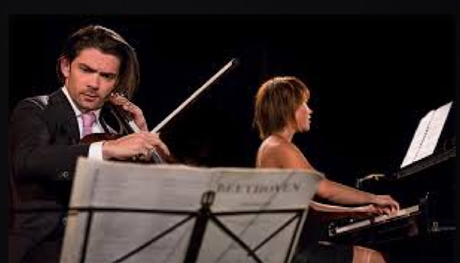by Paul J. Pelkonen

Pierre Capuçon and Yuja Wang came together to play at Carnegie Hall on Wednesday night.
Photo from Medici.TV.
The pair started with César Franck's Violin Sonata in A Major, presented here in a transcription for cello. This work is conceived on an heroic four-movement scale and using some of the same techniques of leitmotivic development that were made commonplace through the influence of Wagner. The sonata was written for the great violinist Eugène-Auguste Ysaÿe. It proved so popular that it was transcribed for any number of secondary instruments. This version for cello was made by Jules Delsart.
Mr. Capucon and Ms. Wang made an engaging pair, chasing each other's tails through dazzling right-hand piano flourishes and short, quick bowstrokes that laced in and out of the keyboard's melodies. Each served as soloist and accompanist, nimbly trading placed and allowing the other musician to come to the fore. The scherzo movement, with its broad structure, massive outer sections and lyrical trio was of a Brucknerian scale, so engaging that the audience burst into its applause at its end thinking that three whole movements had passed. The artists were unfazed and tackled the real slow movement and the hop-scotch finale, their instruments growing closer together as the collaboration warmed up.
The Introduction and Polonaise brilliante by Chopin is an early example of that composer's work, written when he was just 19 as part of a set of music lessons for a nobleman's daughter. Here, the weight rested firmly on Ms. Wang's slender shoulders, as she and her colleague burst into the brilliant passages and flourishes as if to remind the listener that the delicate Chopin was a fierce and independent creator who liked to push the limits of what the piano could do. The theme kept returning to the joyful Polonaise theme, the patriotic dance showing Chopin at his most fervent.
The mature style of Sergei Rachmaninoff confronted the horrors of his century with a determined two-fisted use of melody and the occasional predilection for Russian and Gregorian plainchant. This sonata found the dour Russian in a much friendlier mood, though the solo piano part proves incredibly taxing for a soloist born without Rachmaninoff's freakishly large hand-span. Ms. Wang relied on her dexterity and strength to power through the expansive first movement, bringing the cello alongside in a close dialog that stretched the limit of sonata form.
A fierce Scherzando movement was played with the same vital energy that informs later works like the Symphonic Dances. The players veered into the trio section before returning home for another pounding run-through of the main dance theme. The final Allegro was thrillinag and suspenseful, as the composer's rock-ribbed harmony supported graceful, arching cello lines. The two careened through the last sets of repetition and variation, coming to almost a dead stop and pouring on the gas for the last few pages of the piece.
It's not a YujaWang recital without some impressive encores. First up was "The Swan" from Saint-Saëns' The Carnival of the Animals, a work that so many of today's listeners grew up with but is performed only rarely. The mournful tone of the cello arches over the smoothly undulating piano line. This familiar chestnut was followed by a fire-breathing companion, a dazzling run through the Grand Tango by Astor Piazzolla. This long and somewhat experimental work enthralled some and befuddled others, but there was no denying the bold tone and bright enthusiasm with which Ms. Wang and Mr. Capuçon shone a light on this forgotten corner of the repertory.
If you enjoyed this article, it's time to click over to Superconductor's Patreon page, and help support the cost of independent music journalism in New York City at the low cost of just $5/month.

